What do size marks on bicycle tyre package mean, how to “read” them, which bicycle tyre size can fit a given rim? This post answers all those questions, providing an easy, uniform, standardized way to tell a tyre (tube and rim) size using ISO (ETRTO) standards. For detailed tube sizing gude, see: Bicycle tubes – types, valves and sizing explained. Effect of tyre size on speed and comfort is explained here: Are narrower tyres “faster” – rolling resistance.
If you have any questions (or additions and corrections), please use the BikeGremlin forum:
www.bikegremlin.net
Table Of Contents (T.O.C.):
- Expressing (noting) bicycle tyre dimensions
Table 1: standard bicycle tyre sizes - Tyre widths
Table 2: which tyre width fits which rim width
Table 3: which fat-bike tyre width fits which rim
Table 3b: Schwalbe’s complete size chart
2.1. Why is it important to use an optimal tyre with for your rim width? - Frame fit room (maximum width)
Table 4: real tyre height relative to its pressure and nominal size
Table 5: real tyre width relative to its pressure and nominal size - Tyre size and fitting video
TL/DR
Here, I’ve explained how you can read and understand bicycle tyre size marks (why and how 700 C is the same diameter as 28″ x 1.75 or 29″ – all being the same 622 mm diameter tyres).
I’ve also explained which tyre widths you can fit on your rim and bicycle frame (and how to measure your rim width and frame tight spots).
In the bicycle tubes article I’ve explained which tube dimensions can fit which tyre sizes (and valve types).
1. Expressing (noting) bicycle tyre dimensions
At first, tyre dimensions were expressed through mounted (and inflated) tyre outer diameter. That is why today we still often note tyre sizes like 26″ (now less often), 27.5″ or 29″ for MTB, and 28″ for road bicycles. A 26″ tyre fits on a rim with a 559 mm diameter. When a 2″ wide tyre is mounted on such rim, the outer diameter of such wheel with an inflated tyre is around 660 mm (26″). To further complicate things, different standards were made in different countries. This led to situations that same sized tyres were differently noted, or that the same dimension note was used for tyres that differ in size. Does this sound complicated and confusing already? 🙂 Here’s a picture that takes 26″ “size” as an example:

That is why ISO standard notation was introduced and is in use today. Standard was introduced by ETRTO (The European Tyre and Rim Technical Organisation). Diameter of wheel tyre bead seat in millimetres preceded by tyre width in millimetres. Tyre width is also a bit non-exact measurement. It is width of an inflated tyre mounted on a rim of standard width for that tyre size. However, the most important information: wheel bead diameter is noted exactly in millimetres, so there can be no confusion. 559 wheel and tyre are always compatible (at least in terms of diameter, see about tyre and rim width compatibility below).
When bead seat diameter (BSD) is known, a tyre of appropriate dimensions in mm is required. It is as simple as that.
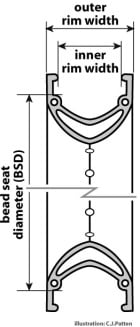
For example, the 26″ wheel diameter is 559 mm and it can take practically any tyre of that BSD, whether wider, or narrower, such as 47-559 (26×1.75″ by old nomination), 60-559 (2.35×26″ by old nomination) and so on. All the manufacturers today mark tyres with ISO dimension standards, sometimes adding old nominations as well, but ISO is always noted and can be used as a safe(st) reference.
Standard road bicycle wheel size today is 622 mm and it usually takes tyres of 23-622, or wider 25-622. Today when off road bicycles with wheels larger than standard MTB wheels started to be popular, it’s wheels are marketed as 29″, but in fact are 622 wheels with wider tyres (so that outer diameter is close to 29″). Tyres for those bicycles are always marked with ISO standard (sometimes along with the “old” standard 29″) saying something like: 57-622, 60-622 and similar, depending on tyre width.
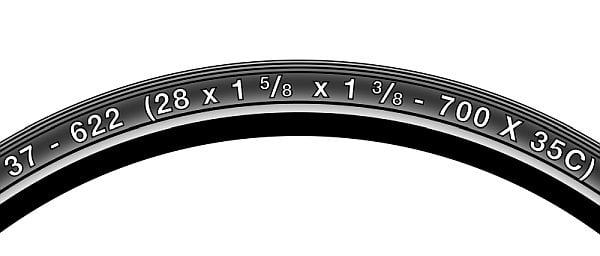
In case a tyre has no ISO (ETRTO) marks, here is a cross-reference:
| ISO (ETRTO) Bead Seat Diameter | Traditional Designations |
|---|---|
| 787 mm | 36 inch |
| 686 mm | 32 inch |
| 635 mm | 28 x 1 1/2, 700 B |
| 630 mm | 27 x anything except “27 five” |
| 622 mm | 700 C, 28 x (two fractions), 29 inch, 28 x 1 1/2 F.13 Canada Road 28″ wheels and MTB 29″. |
| 599 mm | 26 x 1.25, x 1.375 |
| 597 mm | 26 x 1 1/4, 26 x 1 3/8 (S-6) |
| 590 mm | 26 x 1 3/8 (E.A.3), 650 A |
| 587 mm | 700 D |
| 584 mm | 650B, 26 x 1 1/2, 27.5″ MTB 27,5″ wheels |
| 571 mm | 26 x 1, 26 x 1 3/4, 650 C |
| 559 mm | 26 x 1.00- x 2.125, also fatbike tyres up to 5 inches wide MTB 26″ wheels. |
| 547 mm | 24 x 1 1/4, 24 x 1 3/8 (S-5) |
| 540 mm | 24 x 1 1/8, 24 x 1 3/8 (E.5), 600 A |
| 520 mm | 24 x 1, 24 x 1 1/8 |
| 507 mm | 24 x 1.5- x 2.125 – Big kids bikes with 24″ wheels. |
| 490 mm | 550 A |
| 457 mm | 22 x 1.75; x 2.125 |
| 451 mm | 20 x 1 1/8; x 1 1/4; x 1 3/8 |
| 440 mm | 500 A |
| 419 mm | 20 x 1 3/4 |
| 406 mm | 20 x 1.5- x 2.125 – Kids small 20″ wheels, BMX. |
| 390 mm | 450 A |
| 369 mm | 17 x 1 1/4 |
| 355 mm | 18 x 1.5- x 2.125. Kids’ bikes with 18″ wheels. |
| 349 mm | 16 x 1 3/8 |
| 340 mm | 400 A |
| 337 mm | 16 x 1 3/8 |
| 317 mm | 16 x 1 3/4 |
| 305 mm | 16 x 1.75- x 2.125 – Kids’ 16″ wheels. |
| 288 mm | 14 x 1 3/8″ |
| 254 mm | 14 x 2.00. Kids’ 14″ bike wheels. |
| 203 mm | 12 1/2 X anything. Small kids’ 12″ wheels. |
| 152 mm | 10 x 2 |
| 137 mm | 8 x 1 1/4 |
Table 1
2. Tyre widths
After explaining tyre dimensions, a few words on tyre widths. Generally, narrower tyres are good for fast road riding on pavement, while wider tyres are better suited to rough terrain, or heavily loaded bicycles (heavy rider, carrying children or heavy baggage on a bicycle etc.). Depending on rim width, a range of tyre widths can be used. The important measure here is inner rim width. Outer rim width is irrelevant (for this purpose), just the inner rim diameter.
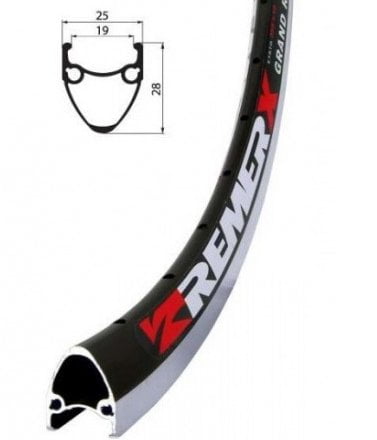
The following table tells the range of acceptable tyre widths depending on inner rim width, expressed in mm, according to ISO (ETRTO) standard:
| Tyre width (mm) / Rim width | 18 | 20 | 23 | 25 | 28 | 32 | 35 | 37 | 40 | 44 | 47 | 50 | 54 | 57 | 60 | 62 |
| 13 | x | x | x | x | ||||||||||||
| 15 | x | x | x | x | ||||||||||||
| 17 | x | x | x | x | x | x | x | x | x | |||||||
| 19 | x | x | x | x | x | x | x | x | x | x | ||||||
| 21 | x | x | x | x | x | x | x | x | x | x | ||||||
| 23 | x | x | x | x | x | x | x | x | x | |||||||
| 25 | x | x | x | x | x | x | x | |||||||||
| 27 | x | x | x | x | x | x | ||||||||||
| 29 | x | x | x | x |
Table 2
Fat-bicycle tyre sizing chart:
| Tyre width (mm) / Rim width | 65 2.60″ | 70 2.80″ | 80 3.10″ | 100 4.0″ | 110 4.40″ | 115 4.50″ | 120 4.80″ |
30 | x | x | x | ||||
| 31 | x | x | x | ||||
32 | x | x | x | ||||
33 | x | x | x | ||||
34 | x | x | x | ||||
35 | x | x | |||||
40 | x | x | |||||
45 | x | x | |||||
50 | x | x | x | x | |||
| 70 | x | x | x | ||||
| 100 | x | x |
Table 3
Below is a chart which includes many modern (more recent) tyre and rim widths. It was made by the Schwalbe company and in my experience it is a safe guide (I’ve even exceeded the there-recommended ranges without problems). Both the dark-blue Schwalbe range, and the light-blue ETRTO range are fine – as long as you stay within either of those, you’ll be fine:

Source: www.schwalbe.com
Table 3b
2.1. Why is it important to use an optimal tyre with for your rim width?
If a tyre that is too narrow is mounted on a wide rim, the rim can easily be damaged on a bump. If too wide a tyre is mounted, there is a risk of the tyre coming off a rim (with a loud explosion of the tube). Either of the two extremes can reduce traction and comfort (shock absorption), and distort the optimal tread/knob design. In addition to that, using a tyre that is too wide for the rim width can expose the tyre’s sidewalls to cuts (I’ve had this “pleasure” with a rather expensive 28mm tyre mounted on a 13 mm wide rim).

Source: Stan’s NoTubes
Help BikeGremlin
stay online & independent
This website is educational, free, objective, and not commercial
(sponsors don’t enjoy paying if you mention all the product downsides that you notice 🙂 ).
How much does a WordPress website cost?
If you find this site to be good and helpful,
and if $5 per month is what you can afford to set aside,
please consider supporting my work with a Patreon donation:
3. Frame fit room (maximum width)
If there’s limited space for fitting tyres in a frame, note that rim width also influences tyre width and height when mounted:
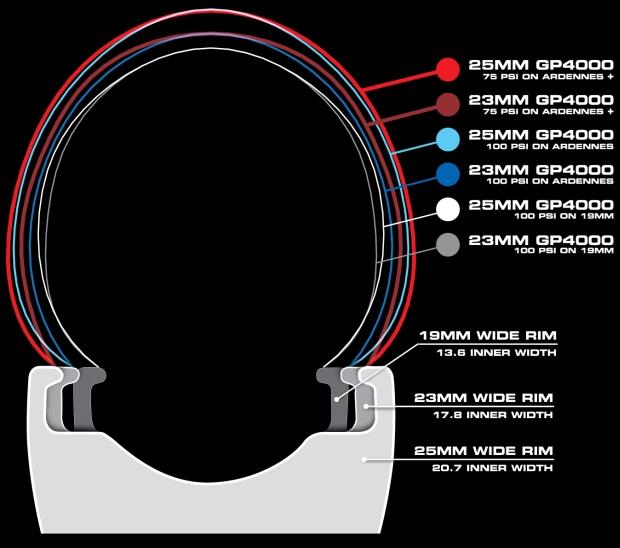
It should be also noted that one nominal tyre size (e.g. 622-28), in various models and manufacturers, is not of the same actual width when mounted and inflated. Some models are known to be of a smaller “real” size, some are known to be larger. If, for example, the old tyre has a nominal width of 23 mm, and one considers replacing it with a wider one of 25 mm (nominal) width, and there is only about two mm extra room, it should be confirmed what the actual tyre widths when mounted are. If the old 23 mm tyre is among the “narrower 23s”, and the considered 25 mm one is among the “wider 25s”, it is very likely that the wheel will not fit into the frame with the new tyre.
Pictures below are taken on a frame with lots of extra room for wider tyres (and mudguards). They are just a demonstration of where the “tight” spots usually are, and where attention should be paid (and measuring taken) before going for wider tyres. Depending on frame geometry and brake type, some other spots may be the tight ones. It should always be checked and measured at the tightest spot, with the least tyre clearance – and that is usually in (one of) these places:

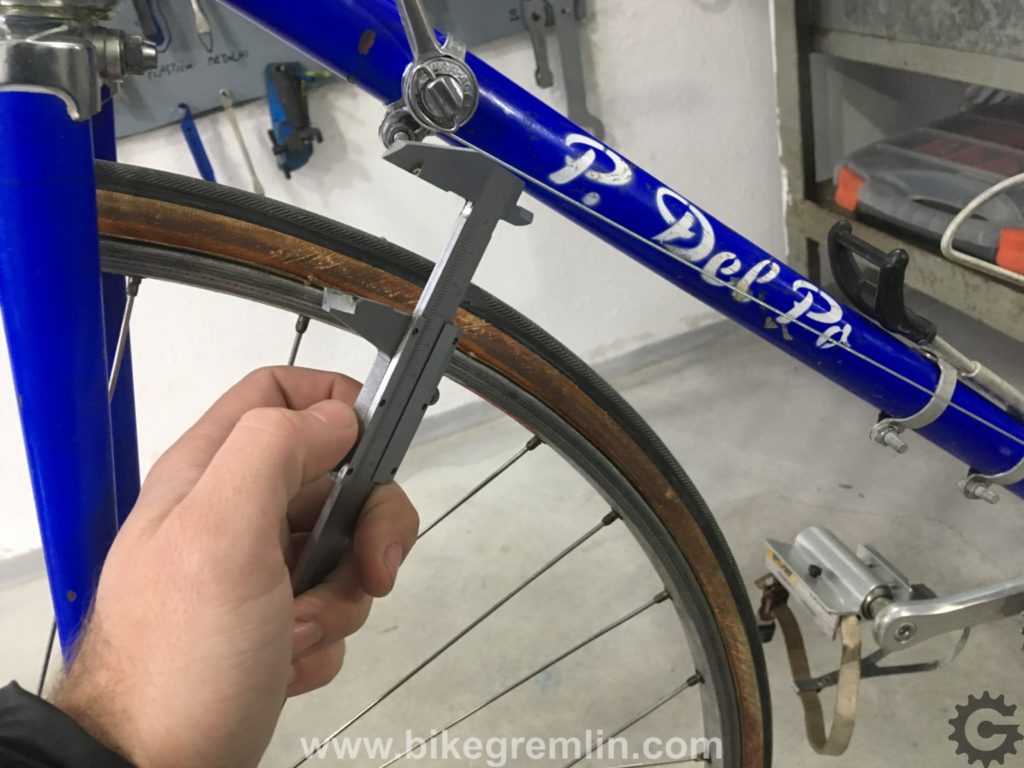

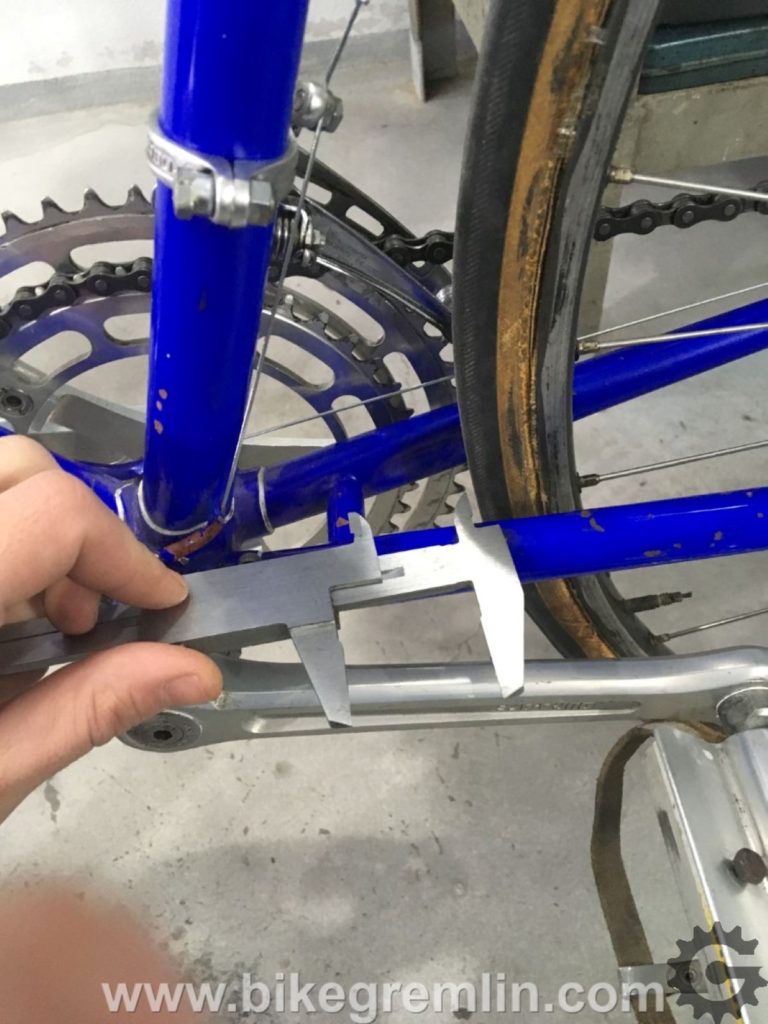
The bicycle in the picture has huge clearance – they used to make them properly in the 70s 🙂
Table overview of how tyre inflation pressure affects its real height, depending on its nominal size (dimension) – inner rim width used or measuring was 19 mm:
| Tyre model and nominal dimension | Real height at 3 bars pressure | Real height at 4.5 bars pressure | Real height at 6 bars pressure |
|---|---|---|---|
| Continental Grand Prix 4-Season ETRTO 622-28 | 27 mm | 27.5 mm | 28 mm |
| Continental Terra Trail ETRTO 622-35 | 32 mm | 32.5 mm | 32.75 mm |
| Schwalbe Lugano 2 ETRTO 622-25 | 22 mm | 22.5 mm | 22.75 mm |
Table 4
Table overview of how tyre inflation pressure affects its real width, depending on its nominal size (dimension) – inner rim width used or measuring was 19 mm:
| Tyre model and nominal dimension | Real width at 3 bars pressure | Real width at 4.5 bars pressure | Real width at 6 bars pressure |
|---|---|---|---|
| Continental Grand Prix 4-Season ETRTO 622-28 | 29.5 mm | 29.7 mm | 30.1 mm |
| Continental Terra Trail ETRTO 622-35 | 34.7 mm | 34.8 mm | 35.15 mm |
| Schwalbe Lugano 2 ETRTO 622-25 | 24.6 mm | 24.8 mm | 25.3 mm |
Table 4
4. Tyre size and fitting video
Related post – To what pressure should I inflate my bicycle tyres:

If you have any questions (or additions and corrections), please use the BikeGremlin forum:
www.bikegremlin.net
The existing comments posted under this article (questions and answers) have been moved to this BikeGremlin forum thread:
https://www.bikegremlin.net/threads/bicycle-tyre-sizing-and-dimension-standards-article-comments.103/

Hi,
Thanks for such a nice explanation. First a little background. I have a Drag bike Rodero TE exact specification like this one here; dragzone. bg/en/drag-rodero-te-bike-2018. It originally can with the Schwalbe Spicer K-Guard, 30-622 tires though the rim is designated at these numbers: ETRTO 622x13c. There is also this numbering, ERD: 593, I am not sure what ERD means. Anyways, while the ‘conservative’ chart says rim sizes of 622 x 13c (700x 13c) can fit as far as 25mm (700x 25c), my bike came fitted with 700x 30c. I have had no problems whatsoever until I recently changed to Maxxis Relix (SilkShield, One70) 700x23c tires because it seemed fine that they will fit nicely and 25c ones were not available. The roads that I am riding these days are a combination of gravel and tarmac. I have had flat tires several times and seems to me that this purchase hasn’t paid off. I want to change my tires to gravel types ones but I am eternally confused with the sizes. Looks like my rim can take as much as 700x30c, should I look for these sizes for gravel type tires? Or should I buy a separate wheel-set dedicated to gravel? While having a new wheel-set sounds nice, I am not very sure if my rim brakes (mechanical) and the 10 speed Shimano Tiagra cassette will be compatible. What will be the best course of action? Thanks in advance.
ERD is “effective rim diameter” – relevant for wheel building, when calculating the optimal spoke lengths. In this video, at 6:40 I explain how it is measured:
https://www.youtube.com/watch?v=i5ywzfr_dCg&list=PLlbCLBTvuIssCHYrqh9BM8IrtEV2SaD_3&index=4
As for the tyre sizes, the chart is rather conservative, at least in my experience. Also, some tyres are made “half a size” smaller, or larger, than what is noted on the sidewall. So you might “get away” with tyres wider than 25 mm on 13 mm rims. I would definitely measure the rim’s inner width just to be sure.
Having said this, wider rims will provide for more air volume inside the tyres, since tubes will expand more inside the rim, hence probably allowing for somewhat more comfortable ride with the same size of tyres, compared to narrower rims. The differences are not night and day, but they do exist.
I personally don’t like tyres narrower than 28 mm, even on road bicycles. Wider ones don’t need very high pressure, so they don’t have to be topped up too often and can be inflated with a small, cheap, portable pump that fits a patch kit easily. Also, lower pressure (wider) tyres are a lot less prone to punctures by sharp rocks, or glass shards, at least in my experience.
Hi. Thanks for your information in this article. I’m having trouble relating what I find in articles such as this to the tyre sizing for my daughter’s bike. She has a smaller bike being a child, 20 inch wheels. When I was shopping around for new tyres the narrowest I could find at 20 inch was 2.15 inch width. But the tyre I bought looks considerably wider than the existing one. I’m not sure it will fit. So i used your width table. Her inside rim width is 15 mm, and the table seems to suggest a max tyre width of 1.26”. But the tyre she has now is 1.5” and that looks fine. So I’m thinking that I have misunderstood what the tyre width in the table actually is.
Would you be able to help me check my understanding of the table? Thanks for any help you can give.
The given table is rather “conservative” – in terms that it gives combinations that will most certainly fit and work fine, with practically any rim and tyre make/model/diameter.
I have run combinations that are out of the limits given by the chart, with no problems.
So, to be on the safe side (without being able to see how the tyre fits a rim), the table should be respected.
Especially since some tyres are made to be a bit wider, or narrower than their sizing specifications show (depends on the manufacturer, and tyre model/mold).
Having said all that, bearing in mind that 1.5″ tyre is working fine, I wouldn’t shy away from using that width of tyres – just making sure they are seated well.
Hi there,
I have an old Gazelle city bike of 1973 with the tire dimensions of 28 x 1 3/8 x 1 5/8. It is quite difficult to find tires of those dimensions in my country, Indonesia. What is the alternative tire dimensions that suitable/compatible to the current tires dimensions? Any suggestion? thanks
Most tyres have ISO marks as well, especially ones made in the past 20 years.
If these don’t, however, I would try with 37-622 (32 mm wide “28 inch”) tyres.
I appreciate the information! Very clear and well thought out.
Thank you
So, which two wheelers performance is better? Two wheeler with bigger tyre or two wheeler with smaller tyre?.
Please give me ans.
It depends. I wrote on that topic in the article:
Are narrower tyres “faster”?